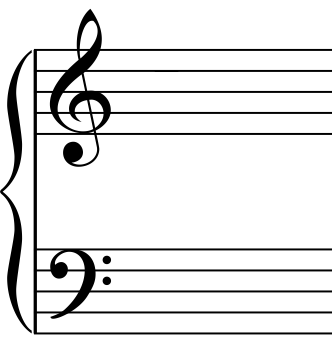Piano Blog by Skoove – Piano Practice Tips
The grand staff is one of the most important reading concepts to master on the piano. Most piano music is notated on the grand staff. Because of the grand staff’s extended range, we can easily see which parts of our music should be played with the left hand and which parts should be played with the right hand.
At first glance, the notes on grand staff may seem like a lot of information to take in at once. How am I supposed to read music for both hands at the same time? But, if you take things slowly step-by-step, you will find the grand staff is actually much easier to read than you first anticipated.
Key Takeaways:
The grand staff is the combination of two staves, treble and bass clef, joined together with a bracket.
It is most commonly used to notate piano music.
We can clearly see the parts played by the left and right hands.
What is a grand staff?
The grand staff is simply the combination of treble and bass clef, joined together with a bracket. It looks like this:
How to use the grand staff?
The grand staff is most commonly used to notate piano music. It is an effective way to see which parts of the music should be played with the left hand and which parts should be played with the right hand. It is hugely important to understand when you learn to read music.
In general, the music notated in the treble clef is performed with the right hand and the music notated in the bass clef is performed with the left hand.
Sometimes, you will find examples where your hands cross or overlap, but those are usually in more advanced piano music.
The lines of grand staff: invisible line
The grand staff allows us to understand the mystery of middle C. Middle C is on an invisible line in the middle of the grand staff. Check it out here:
This is why middle C is called so. Middle C is not called middle C because it is in the middle of the piano. It is called middle C because it is in the middle of the grand staff!
Middle C is notated here in treble clef:
And middle C is notated here in the bass clef:
Do you see how when we combine the two clefs together into the grand staff, these two notes are in the exact same position, one ledger line above or below the staff?
We add these additional invisible lines to the grand staff to account for the notes on a piano that extend beyond the grand staff. We call these lines ledger lines. We can have ledger lines in both treble clef and bass clef.
Occasionally, you will see notes written on ledger lines two, three, four, or even five lines above or below the staff. In the case of ledger lines below the treble clef, we could actually notate these pitches in the bass clef and in the case of ledger lines above the bass clef, we could notate these pitches in the treble clef.
However, composers often do not do this in order to maintain clarity in a score and to have the positions of both hands in treble and bass clef easily displayed.
Notes of the grand staff
Grand staff notes: treble staff
The notes on grand staff include both the treble and bass clefs. The notes of the treble staff are simple to memorize if you use mnemonic devices for the lines and spaces. The treble clef notes are as follows:
Grand staff notes: bass clef
The lines and spaces of bass clef are likewise quite easy to memorize if you use a mnemonic device. You can also imagine the lines and spaces in the bass clef are one jump down from those in treble clef.
For example, the note on the second line in treble clef is G and the note on the first line of bass clef is G. The G in the treble clef is one line above the bass clef G and vice versa. Here are the bass clef notes:
Grand staff notes: the total combo
When we combine both the notes of the treble staff and the staff notes in bass clef, the notes on grand staff look like this:
Beautiful, isn’t it?
Conclusion
Learning to read the notes on the grand staff is a beneficial and necessary step on your journey to piano greatness. All great pianists understand how to read on it.
And remember, Skoove is here to help you on your journey to piano greatness! Whether you need some help recognizing pitches, learning to recognize notes on the piano keyboard, or are interested in new songs and ideas, Skoove is an excellent choice. Plus, with a free 7 day trial, you have all the time to test it out! See what you can learn today!
Author of this blog post
Eddie Bond is a multi-instrumentalist performer, composer, and music instructor currently based in Seattle, Washington USA. He has performed extensively in the US, Canada, Argentina, and China, released over 40 albums, and has over a decade experience working with music students of all ages and ability levels.
Read More
This article is from an external source and may contain external links not controlled by Empeda Music.
